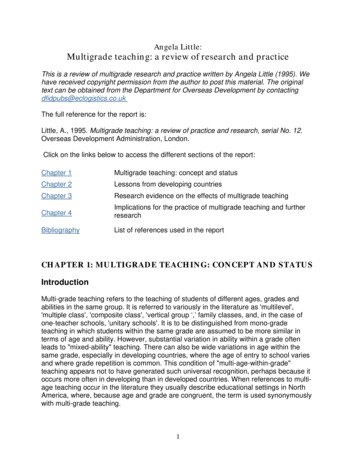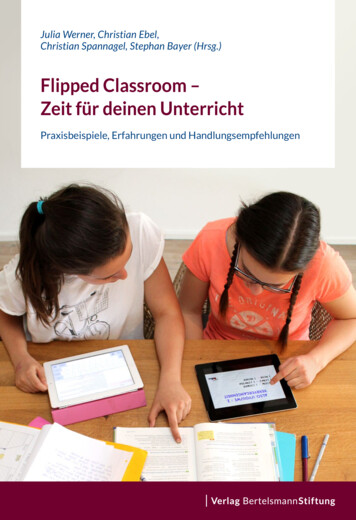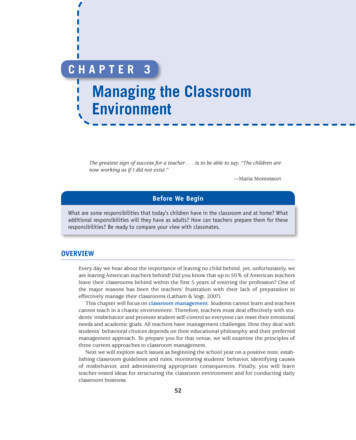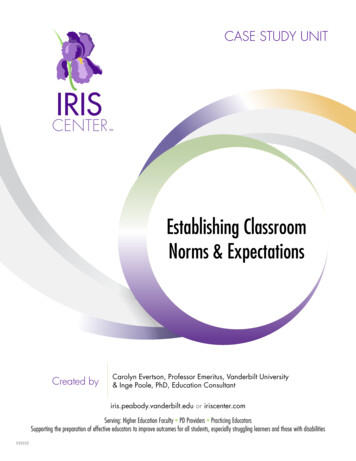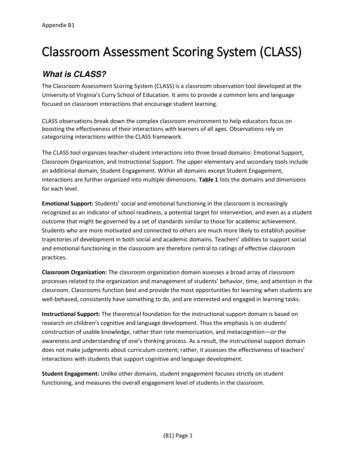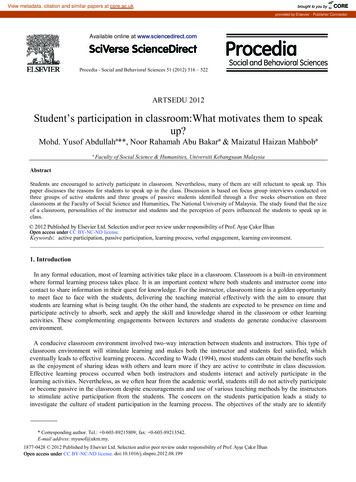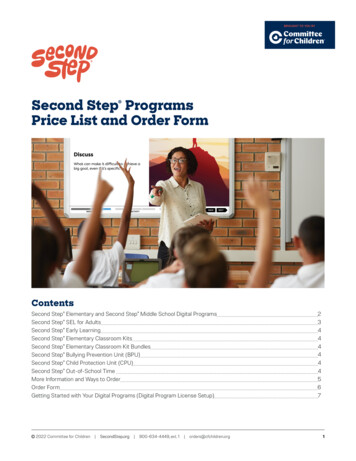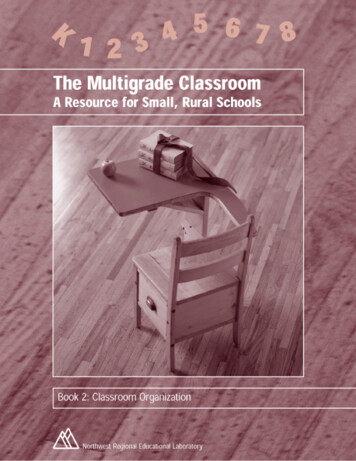
Transcription
THE MULTIGRADE CLASSROOM:A RESOURCE HANDBOOK FOR SMALL,RURAL SCHOOLSBook 2: Classroom OrganizationNovember 1999Rural Education ProgramBased on the September 1989 publicationof the same title written by Bruce A. MillerSusan Vincent, EditorJoyce Ley, DirectorNorthwest Regional Educational Laboratory101 S.W. Main Street, Suite 500Portland, Oregon 97204
AcknowledgmentsThe following selections have been reprinted with permission:Cohen, E. (1986). Designing groupwork: Strategies for the heterogeneous classroom (pp. 207–209). New York, NY: Teachers College Press. (Reprintedwith permission of publisher.)Emmer, E.T. (1987). Classroom management and discipline. In V.Richardson-Koehler & D.C. Berliner (Eds.), Educators’ handbook:A research perspective (pp. 233-258). White Plains, NY: Longman.(Reprinted with permission of publisher.)Evertson, C.M., Emmer, E.T., Clements, B.S., Sanford, J.P., & Williams, E.(1981). Organizing and managing the elementary school classroom. Austin,TX: University of Texas, Research and Development Center for TeacherEducation. (Reprinted with permission of Carolyn Evertson, PeabodyCollege, Vanderbilt University, Nashville, TN.)Gaustad, J. (1994). Nongraded education: Overcoming obstacles to implementing the multigrade classroom [Special issue]. OSSC Bulletin, 38(3& 4). (Reprinted with permission of author.)Gibbons, M., & Phillips, G. (1978). Helping students through the selfeducation crisis. Phi Delta Kappan, 60(4), 296–300. (Reprinted withpermission of publisher.)Kagan, S. (1989). Cooperative learning: Resources for teachers. San JuanCapistrano, CA: Resources for Teachers. (Reprinted with permissionof publisher.)Karweit, N. (1987). Diversity, equity, and classroom processes. In M.T.Hallinan (Ed.), Social organization of schools: New conceptualizations of thelearning process (pp. 71–102). New York, NY: Plenum Press. (Reprintedwith permission of publisher.)Kentucky Department of Education. (1996). Nearly all Kentucky schools showimprovement in latest KIRIS scores, but middle schools lag behind [Pressrelease]. Frankfort, KY: Author. (Reprinted with permission of author.)Murphy, J., Weil, M., & McGreal, T. (1986). The basic practice model ofinstruction. Elementary School Journal, 87(1), 83–96. (Reprinted withpermission of the University of Chicago Press.)Oregon Department of Education, & Ackerman Laboratory School. (1994).Mixed-age programs, 1993–94. Salem, OR: Oregon Department ofEducation. (Reprinted with permission of publisher.)Pavan, B.N. (1992). The benefits of nongraded schools. EducationalLeadership, 50(2), 22–25. (Reprinted with permission of author.)iiThe Multigrade Classroom
Slavin, R.E. (1987). Ability grouping and student achievement in elementary schools: A best-evidence synthesis. Review of Educational Research,57(3), 293–336. (Reprinted with permission of the AmericanEducational Research Association.)Slavin, R.E. (1988). Synthesis of research on grouping in elementary andsecondary schools. Educational Leadership, 46(1), 67–77. (Reprintedwith permission of the Association for Supervision and CurriculumDevelopment.)Slavin, R.E., & Madden, N.A. (1989). What works for students at risk:A research synthesis. Educational Leadership, 46(5), 4–13. (Reprintedwith permission of the Association for Supervision and CurriculumDevelopment.)Thomas, J.W., Strage, A., & Curley, R. (1988). Improving students’ selfdirected learning: Issues and guidelines. Elementary School Journal, 88(3),313–326. (Reprinted with permission of the University of Chicago.)iii
OverviewPrefaceThe preface describes the process used in developing this handbook,including the multigrade teachers who shared their classroom strategiesand ideas for improving the usefulness of the handbook.IntroductionThe history of multigrade classroom instruction is presented, alongwith the background information that describes why multigradeinstruction is an important and complex issue for educators.Book 1: Review of the Research on Multigrade InstructionIn this book, the research on multigrade instruction is reviewedin order to answer two questions: (1) What effect does multigradeinstruction have on student performance? and (2) What kind of training is needed in order to teach in a multigrade classroom? Detailedinformation focusing on organizing and teaching in a multigrade classroom is also presented.Book 2: Classroom OrganizationThis book describes strategies for arranging and organizing instructional resources and the physical environment of the classroom. Sampleclassroom layouts and a “design kit” for organizing your classroom arealso included.Book 3: Classroom Management and DisciplineEstablishing clear expectations for student behavior and predictableclassroom routines has been shown to improve student performance.In this book, research relating to classroom management and disciplineare presented, along with a checklist for planning management routinesand discipline procedures.Book 4: Instructional Organization, Curriculum, and EvaluationResearch-based guidelines for planning, developing, and implementinginstructional strategies are presented. This book emphasizes the development of cooperative work norms in the multigrade classroom andexplains how to match instruction to the needs of students. An overviewof curriculum and evaluation planning concepts is also provided. Thisbook is a close companion piece with book 5: Instructional Deliveryand Grouping.ivThe Multigrade Classroom
Book 5: Instructional Delivery and GroupingThis book emphasizes that instructional quality and student groupingare key components for success in the multigrade classroom.Instructional methods such as recitation, discussion, and cooperativelearning are reviewed. Planning guides and examples are also includedwhere appropriate. Strategies for organizing group learning activitiesacross and within grade levels, especially those that develop interdependence and cooperation among students, are discussed.Book 6: Self-Directed LearningDeveloping skills and strategies in students that allow for a high levelof independence and efficiency in learning, either individually or incombination with other students, is essential in the multigrade classroom. Ideas for developing self-direction are presented in this book.Book 7: Planning and Using Peer TutoringThis book provides guidelines for developing skills and routines wherebystudents serve as “teachers” to other students within and across differing grade levels. The research on what makes for effective tutoring inthe classroom is also reviewed.v
Prefacehe development of this handbook began in 1987, when a groupof people involved in rural education raised several issues regardingmultigrade classroom instruction.TIn their discussions, members of the advisory committee for theNorthwest Regional Educational Laboratory’s (NWREL) Rural EducationProgram agreed that multigrade teacher training in their respective stateswas either lacking or wholly inadequate. They also were concerned aboutthe availability of research and training materials to help rural multigradeteachers improve their skills.As a result of these concerns, the Rural Education Program decided todevelop a handbook to assist the multigrade teacher. The handbook evolvedin several stages. The first was a comprehensive review, conducted by Dr.Bruce Miller, of the research on multigrade instruction that included articles,books, and research reports from the United States, Canada, Australia, andother countries.From this review, six topic areas emerged that are considered essential foreffective multigrade instruction: classroom organization; classroom management and discipline; instructional organization, curriculum, and evaluation;instructional delivery and grouping; self-directed learning; and planning andusing peer tutoring. Dr. Miller developed the handbook around these sixinstructional areas, and a draft was completed in June 1989, with supportfrom the Office of Educational Research and Improvement (OERI).The second stage occurred in July 1989, when a conference was held inAshland, Oregon, with multigrade teachers who were recommended by educational leaders from throughout the Northwest and Pacific Island regions.During the conference, participants were organized into workgroups,each focusing on one of the topic areas. Their tasks were to review theappropriate handbook chapter for clarity and content, to suggest alternativeand/or additional instructional strategies to those presented in the handbook,and to write case descriptions of activities drawn from their classrooms.For example, Joel Anderson from Onion Creek Elementary in Colville,Washington, described how he grouped students for cooperative learning.Darci Shane from Vida, Montana, presented a school handbook she haddeveloped for parents that included a class schedule and other school-relatedinformation. (A full list of participants appears at the end of this preface.)The final handbook was completed by Dr. Miller in September 1989.Based on the growing interest and research on multigrade instructionthe handbook was revised and updated in 1999, also with support fromOERI. The final version, completed with support from the Institute ofInternational Education (IIE), is now composed of a series of seven standalone books.viThe Multigrade Classroom
BookBookBookBookBookBookBook1:2:3:4:5:6:7:Review of the Research on Multigrade InstructionClassroom OrganizationClassroom Management and DisciplineInstructional Organization, Curriculum, and EvaluationInstructional Delivery and GroupingSelf-Directed LearningPlanning and Using Peer TutoringPurpose and Scope of the Handbookhe handbook has been written to serve three general purposes:TlTo provide an overview of current research on multigradeinstructionlTo identify key issues teachers face when teaching in a multigrade settinglTo provide a set of resource guides to assist novice andexperienced multigrade teachers in improving the qualityof instructionHowever, because of the complexity of multigrade instruction and thevast amount of research on effective classroom instruction, this handbookcan only serve as a starting point for those educators wanting to learn newskills or refine those they already possess.Each book of the series presents information, strategies, and resourcesconsidered important for the multigrade teacher. While all the books arerelated, they also can stand alone as separate documents. For example, thebooks on Classroom Organization (Book 2) and Classroom Managementand Discipline (Book 3) contain overlapping information. Ideally, thesetwo books are best utilized together. The same is true of the books onInstructional Organization, Curriculum, and Evaluation (Book 4) andInstructional Delivery and Grouping (Book 5). Wherever possible, theserelationships have been noted in the appropriate books.In conclusion, the series of books has been designed to be used asa research-based resource guide for the multigrade teacher. It covers themost important issues the multigrade teacher must address to be effectivein meeting the needs of students. Sample schedules, classroom layouts,resource lists, and strategies aimed at improving instruction have been usedthroughout. It is our hope that the handbook will raise questions, provideanswers, and direct the multigrade teacher to resources where answers toother questions can be found.vii
Participants in the Multigrade ConferenceKalistus NgirturongAimeliik ElementaryBabeldaob IslandRepublic of PalauRobin LovecSpringdale SchoolSpringdale, MontanaAnthony MoorowYap Department of EducationColonia, YapCheryl MikolajcvykKaumakakai, HawaiiLeslie GordonPitkas Point SchoolSt. Mary’s, AlaskaJames MakphieMajuro, Marshall IslandsEdith NicholasAndrew K. Demoski SchoolNulato, AlaskaBenjamin BernardMajuro, Marshall IslandsLinda PelroyW.W. Jones ElementaryArock, OregonJohn RusyniakMentasta Lake SchoolMentasta Lake, AlaskaPatricia ReckBrothers SchoolBrothers, OregonBill RadtkeEnglish Bay SchoolEnglish Bay, AlaskaPhil M. GilliesStone ElementaryMalad, IdahoCarol SpackmanPark Valley SchoolPark Valley, UtahviiiBarbara RobinsonArbon Elementary SchoolArbon, IdahoMonte Phoenix and KarriePhoenixOrovada, NevadaJoel AndersonOnion Creek ElementaryColville, WashingtonMarty KarlinTrinity Center SchoolTrinity Center, CaliforniaTroy SmithDixie Elementary SchoolDixie, WashingtonJill BillsSanders Elementary SchoolSanders, ArizonaDarci ShaneSouthview SchoolVida, MontanaEileene ArmstrongMelrose ElementaryMelrose, MontanaPam CunninghamSand Springs ElementarySand Springs, MontanaJennifer McAllisterDeerfield ElementaryLewistown, MontanaKimberly RindalAyers ElementaryGrass Range, MontanaSammy VickersGrant ElementaryDillon, MontanaBrian WolterAvon ElementaryAvon, MontanaThe Multigrade Classroom
Introductionn contrast to a historical pattern of children developing within an agevaried social system, many children today spend a majority of theirtime in an age-segregated milieu (Katz, Evangelou, & Hartman, 1990;McClellan, 1994). The results of this pattern of segregation are thought tocontribute to a declining social support system and compromised development of children’s social and academic skills.IColeman (1987) suggests the need for a significant institutional andsocietal response to support functions traditionally filled by the family, suchas the development of feelings of belonging and community, emotional andsocial bonding, and nurturance. Increasingly, the school has been viewed asone of the most effective and efficient contexts to address children’s academic,affective, and social needs before these needs reach crisis proportions.A growing body of research explores the influence of educationalcontexts on children’s development. While interest has focused on theimpact of the classroom environment on children’s attitudes toward school,cognitive growth, and academic development, less direct attention has beengiven to the relationship between classroom context (including the structureand content of children’s peer relationships) and academic and social development during the elementary years. One approach explored by theoreticians and researchers for encouraging children’s academic and social skilldevelopment is multigrade instruction.In multigrade instruction, children of at least a two-year grade spanand diverse ability levels are grouped in a single classroom and are encouraged to share experiences involving intellectual, academic, and social skills(Goodlad & Anderson, 1987; Katz et al., 1990; McClellan & Kinsey,1996). Consistency over time in relationships among teachers, children,and parents is viewed as one of the most significant strengths of the multigrade approach because it encourages greater depth in children’s social,academic, and intellectual development. The concept of the classroom as a“family” is encouraged, leading to expansion of the roles of nurturing andcommitment on the part of both students and teacher (Feng, 1994;Hallion, 1994; Marshak, 1994).The potential academic and social implications of the multigradeconcept of education are strongly supported by extensive research demonstrating the importance of peers in children’s academic and social development, and by studies of reciprocity theory, which demonstrate the positiveeffect on child academic and social behavior of sustained close relationshipsbetween children and caregivers (Kinsey, 1998; Maccoby, 1992).The adequate implementation of a multigrade approach to educationextends beyond simply mixing children of different grades together. Apositive working model of a multigrade classroom allows for the development of academic and social skills as the teacher encourages cross-ageix
interactions through tutoring and shared discovery. Social competencedevelops for older children out of their roles as teachers and nurturers, andfor younger children out of their opportunity to observe and model thebehavior of their older classmates (Katz et al., 1990; Ridgway & Lawton,1969).The multigrade classroom has traditionally been an important andnecessary organizational pattern of education in the United States, notesMiller (1993). Multigrade education dates back to the one-room schoolsthat were the norm in this country until they were phased out in the earlypart of the 1900s (Cohen, 1989; Miller, 1993). From the mid-1960sthrough mid-1970s, a number of schools implemented open education,ungraded classrooms, and multigrade groupings. Although some schoolscontinued to refine and develop the multigrade concept, many of theseprograms disappeared from public schools. With the beginning of theindustrial revolution and large-scale urban growth, the ideal of mass publiceducation took root and the practice of graded schools began in earnest.The graded school system provided a means of organizing and classifying the increased number of urban students of the 1900s. Educators foundit easier to manage students by organizing them into age divisions or grades.Other factors, such as the advent of the graded textbook, state-supportededucation, and the demand for trained teachers, further solidified gradedschool organization (Miller, 1993; Uphoff & Evans, 1993). Critics of thegraded school were quick to emphasize this deficiency. The realization thatchildren’s uneven developmental patterns and differing rates of progress areill-matched to the rigid grade-level system has resulted in a growing interestin and study of the potential benefits of multigrade education in recent years(Miller, 1996). This growing interest is due to a greater focus on the importance of the early years in efforts to restructure the educational system(Anderson, 1993; Cohen, 1989; Stone, S.J., 1995; Willis, 1991) and anawareness of the limitations of graded education.The multigrade classroom is labor intensive and requires more planning,collaboration, and professional development than the conventional gradedclassroom (Cushman, 1993; Gaustad, 1992; Miller, 1996). Sufficientplanning time must be available to meet the needs of both teacher andstudents. Insufficient planning, staff development, materials, support, andassessment procedures will have an impact on the success of the multigradeprogram (Fox, 1997; Miller, 1996; Nye, 1993).Despite these constraints, there are special advantages to multigradeclassrooms. Flexible schedules can be implemented and unique programsdeveloped to meet students’ individual and group interests and needs.Combined classrooms also offer ample opportunity for students to becomeresourceful and independent learners. The multigrade rural classroom isxThe Multigrade Classroom
usually less formal than the single-grade urban or suburban classroom.Because of the small class size, friendly relationships based on understanding and respect develop naturally between the students and the teacher. Inthis setting, students become well-known by their teacher and a familyatmosphere often develops.However, many teachers, administrators, and parents continue towonder whether multigrade organization has negative effects on studentperformance. For most rural educators, multigrade instruction is not anexperiment or a new educational trend, but a forceful reality based oneconomic and geographic necessity. In a society where educational environments are dominated by graded organization, the decision to combine gradesis often quite difficult. The Rural Education Program of the NorthwestRegional Educational Laboratory receives numerous requests from ruraleducators with two overriding concerns regarding multigrade classrooms:lWhat effect does multigrade instruction have on studentperformance?lWhat kind of preparation or training is needed to be an effective teacher in a multigrade classroom?This handbook will provide answers to these questions and develop anoverview of key issues facing school districts and teachers involved in orcontemplating multigrade classrooms.xi
ContentsClassroom Organization .1The Activity Centers Approach .1General Considerations When Planning .2Activity and noise level .2Using visual barriers to define activity areas.4Teacher resources .4Student resources.4Traffic patterns.4Specifying activity centers for students.5Accommodating age differences.5Student belongings .6Explaining Your Room Arrangement .7Floor Plan Design.8Figure 1: Self-contained classroom (organized by areas of activity) .9Figure 2: Self-contained classroom (organized for cooperativelearning) .10Figure 3: Comprehensive classroom layout.11Figure 4: Self-contained classroom (organized for flexibility) .12Designing Your Own Room .13Three-Step Design .14Step 1: Describing the way it is now .15Step 2: Deciding on the types of activities that will occur .16Step 3: Drawing the final plan.17Conclusion .18References .18Resources .21Book 2: Classroom Organizationxiii
Classroom Organizationn the typical multigrade classroom, where multiple activities are likelyto occur at the same time, classroom organization is a critical factor indeveloping smooth, predictable routines. We also know from research oneffective classroom practice that when students have a clear understandingof classroom structure, procedures, and rules, they are more likely to followthem, especially if they have had some involvement in decisionmaking.Although there is no single “best” way to arrange your classroom, thereare some general guidelines that apply to most multigrade settings. Sampleclassroom floor plans and a planning kit have been included to aid you inlaying out your own classroom.IThe Activity Centers Approachn activity center can be defined as any discernible pattern of student orteacher behavior that can be clearly described and labeled. One commonexample is seatwork, where students work independently at a desk.Another example is pairwork, where two students work together. Three ormore students working together is generally characterized as groupwork. Aclassroom may also have areas designated for art, audio-visual equipment,computers, and other instructional resources. Each example reflects a type ofactivity where expectations for behavior may be clearly defined. An activitycenter is best described as an area of the classroom that the teacher has designated for a specific purpose.ATwo other types of centers need to be distinguished from an activitycenter. A learning center is a term used to describe a self-instructionlearning activity that has been placed in a clearly defined area of the classroom. It can be in any subject and generally includes objectives, instructions,and evaluation (see Book 5, Instructional Delivery and Grouping, for moredetail).Another type of center is a subject area resource center. This is anarea where student resources relating to a specific subject are located. Forexample, resources relating to the study of science may all be located in onewell-marked area of the classroom.What types of activities normally occur in your classroom? What typesof activities would you like to occur? Do you have group projects? Are therestudents who tutor? Do you meet with individual students and small groups?Book 2: Classroom Organization1
Is it important for students to be self-directed, or to be able to helpthemselves with little teacher interruption? Answers to these questionsshould help you decide how to arrange your classroom in terms of theactivities that engage students.There are seven general types of activities found in most classrooms:1. Quiet or individual study2. Testing3. Whole-class instruction4. Partner work5. Group discussions6. Audiovisual and reference work7. Teacher tutoring or small-group instructionFurniture and equipment should be arranged to create activity centersappropriate to the type of activity you intend to occur.In the multigrade classroom there may be many different kinds ofactivities going on at the same time. Some students in fourth and fifthgrade might be working on a group art project while two students maybe peer tutoring in math. Two first-graders may meet with the teacher, andseveral students might be completing independent assignments requiringthe use of a tape recorder and the computer. The teacher’s task is to arrangethe classroom so that all these activities can take place at the same time witha minimum of disruption and of teacher direction and supervision.General Considerations When Planninghen deciding how you would like your classroom organized, youmust consider the types of behaviors that are appropriate duringteacher instruction, student independent study, or small-group workand how the arrangement of your classroom will foster these differentlearning activities. Topics to consider when making decisions regardingclassroom arrangement include the following:WActivity andnoise level2When deciding how you will arrange your room in order to accommodatedifferent learning activities, you must consider the level of activity andnoise that is likely to occur. If students work together on a group activity,they are likely to make more noise than if they are independently completing a report or taking a test. Obviously, you would not want to have thesetwo activities happening side by side. Therefore, you should try to arrangecenters from quiet (e.g., independent study) to noisier level (e.g., groupThe Multigrade Classroom
discussion) activities. For example, in one corner of your room you mighthave students working independently. At the opposite corner, studentscould be holding a discussion group.It is helpful to label these different activity areas in your classroomas “centers.” As you define the different learning centers, you will want tospecify the type of behavior appropriate for each area. If you have a readingcenter, for example, you might, in consultation with students, decide thatbooks will be returned after use, that quiet reading is expected, and thatonly a certain number of students can be there at a time.Janet Banks (1997), a multigrade teacher in the Chimacum SchoolDistrict in Washington state, describes one of the ways she controls thenoise level in her classroom:I created a “noise meter” poster that I stick to the chalkboard in front of my class. Thechalkboard is magnetized and I move a refrigerator magnet on the poster to indicate theacceptable level of noise. The levels are labeled: 0-No Voices; 1-Whisper or “Buddy” Voices;2-Table Voices (can only be heard clearly at the student’s table); and 3-Classroom Voices(can be heard clearly across the room, useful during whole-class discussions). At the first ofthe year we practice these different noise levels. In addition, we discuss when the differentlevels are appropriate and why. Many times during the day I let the students choose whichnoise level they wish to work at; sometimes I limit choice to a couple of different levels andsometimes I don’t.The noise meter, as shown below, is a visual reminder of the agreedupon or appropriate noise level. If the students’ noise gets too far abovethis, they are reminded to work more quietly. If it is necessary to do thisagain, the children practice saying a phrase in the appropriate voice andvolume. This way the students get to practice what their voices shouldsound like, and they get to hear what it should sound like in the classroomas a whole.Book 2: Classroom Organization3
Using visualbarriers to defineactivity areasWhen you decide on your activity centers, it is quite helpful to use yourfurniture as a means of defining the boundaries of different work areas.Bulletin boards, portable blackboards, bookshelves, and file cabinets workwell as dividers. These visual barriers help define the different centers andhelp isolate the different levels of activity. However, it is quite importantthat you can see what is occurring at each center from your teacher workarea. This will make it much easier to monitor student behavior. Forexample, if you see that a student is working with another student in theindependent area, you can request they work independently or move to acenter where talking is allowed.Teacher resourcesIt is important to give some thought to the idea of a teacher resource center.This is an area for teacher-controlled resources such as tests, teacher manuals,and assignment files. In addition, this area serves as a place where the teachermeets with individuals or small groups of students. Most teachers simplyput a table, bookshelves, file cabinets, and a blackboard in the center.Student resourcesTraffic patternsYou may wish to place resources used by students in a c
Austin, TX: University of Texas, Research and Development Center for Teacher . Joel Anderson from Onion Creek Elementary in Colville, . In conclusion, the series of books has been designed to be used as a resea


